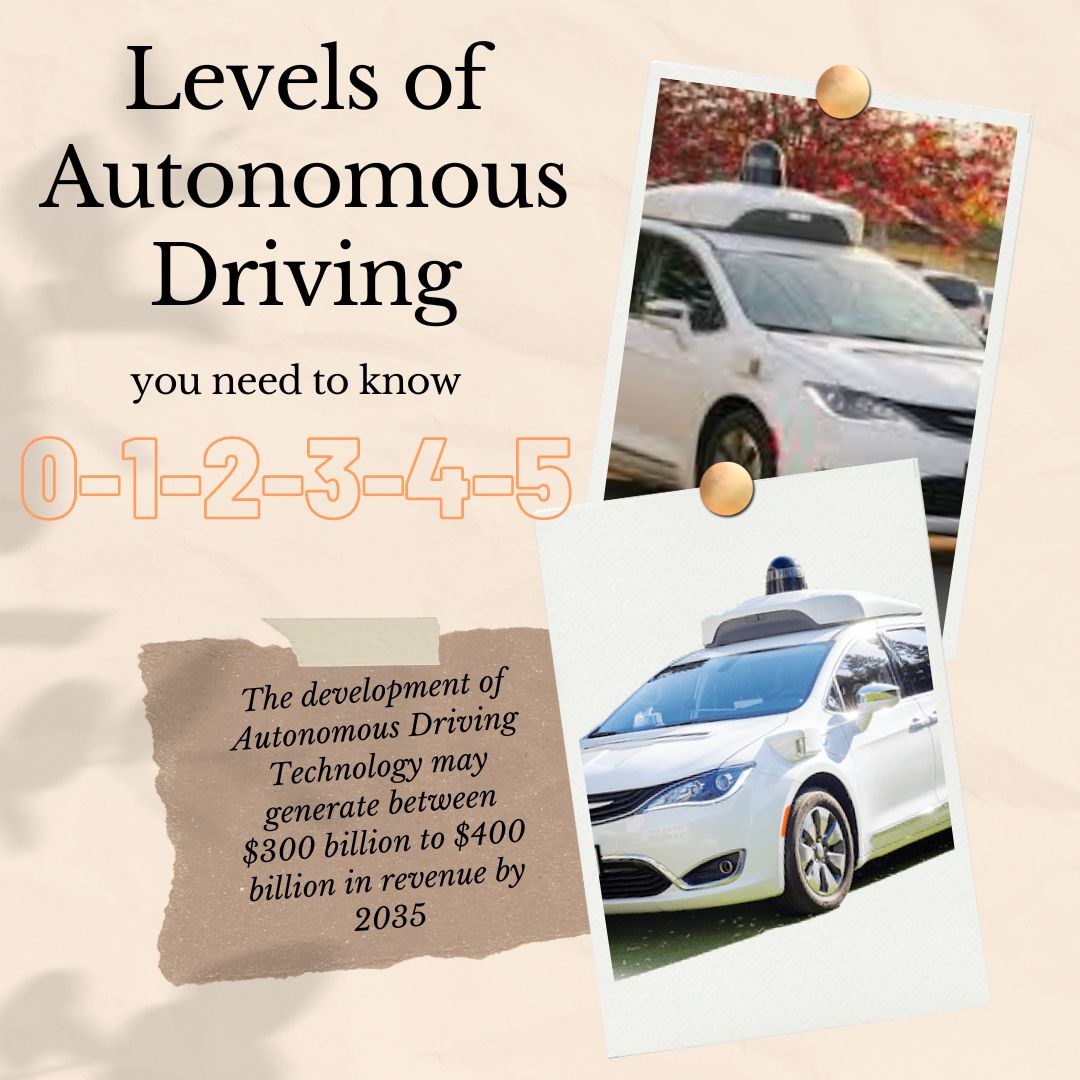Levels of Autonomous Driving You Need To Know

Levels of Autonomous Driving You Need To Know. Autonomous driving has been one of the most promising technological advancements in recent years. But, do you know that autonomous driving is not a binary concept? There are different levels of autonomous driving, each with varying degrees of automation. In this blog post, we will discuss the six levels of autonomous driving and what they mean.
The levels explained by BMW are quoted to better illustrate the levels. Source: BMW
Levels of Autonomous Driving: Level 0
Level 0 of autonomous driving is the starting point of the autonomy spectrum. It refers to vehicles with no automation, meaning that the driver is responsible for all aspects of the driving process. The driver has to maintain control of the vehicle, operate the accelerator, brakes, and steering wheel. This level of autonomy is typical of most vehicles on the road today, and it has been the standard for many years.
At Level 0, the vehicle is purely mechanical and does not rely on any electronic assistance to operate. It’s the most basic level of driving and does not require any complex sensors or computer systems. The driver must be alert at all times and make all driving decisions, including maneuvering around obstacles, changing lanes, and following traffic rules.
Despite the lack of automation, Level 0 vehicles still have safety features such as seatbelts, airbags, and anti-lock brakes. However, these features are not considered part of the automation since they do not contribute to the vehicle’s driving capability.
Level 0 autonomy is still important in today’s world, as it serves as a baseline for measuring progress towards more advanced autonomous vehicles. It’s also crucial for drivers to be aware of their vehicle’s limitations and capabilities, as well as their own driving skills, to ensure safe driving.
In summary, Level 0 autonomous driving involves no automation, and the driver is responsible for all aspects of the driving process. It’s the most basic level of driving, and most vehicles on the road today fall under this category. It’s important for drivers to be aware of their vehicle’s limitations and their own driving skills to ensure safe driving.
Levels of Autonomous Driving: Level 1
Level 1 of autonomous driving is known as “Driver Assistance.” At this level, the vehicle is equipped with systems that can assist the driver in some specific functions, such as braking or accelerating. These systems are designed to help the driver and make driving safer and more comfortable.
For example, a car equipped with adaptive cruise control (ACC) can maintain a safe distance from the car in front of it by automatically adjusting its speed. This means that the driver doesn’t need to constantly adjust their speed and can instead focus on steering the vehicle. Another example is lane departure warning (LDW), which alerts the driver if they are drifting out of their lane.
However, it’s important to note that the driver is still responsible for most of the driving tasks at this level. The driver must maintain control of the vehicle, monitor the road, and take over if necessary. The driver must also be aware of the limitations of the system and not rely too heavily on it.
Overall, Level 1 is a stepping stone towards more advanced autonomous driving, but the driver is still the primary decision-maker and responsible for the safe operation of the vehicle.
BMW Level 1
All BMW vehicles offer level one automation, and many even offer level two. The current BMW Personal CoPilot driver assistance systems support drivers on the road and help ensure additional safety and comfort. Examples of this include the Active Cruise Control with Stop&Go function, which independently adjusts the distance to the car in front of you. And then there is the Collision and Pedestrian Warning with City Brake Activation, which prevents collisions via automatic braking. Source: BMW

Levels of Autonomous Driving: Level 2
Level 2 is a significant step up from Level 1 in terms of automation. At this level, the vehicle has advanced driver assistance systems (ADAS) that can assist with steering, accelerating, and braking, allowing the vehicle to take control of some driving tasks. However, the driver must remain alert and ready to take over at any time because the vehicle still requires human supervision.
Examples of Level 2 automation systems include adaptive cruise control, which automatically adjusts the speed of the vehicle based on the distance from the vehicle in front, and lane departure warning, which alerts the driver if the vehicle is drifting out of its lane. Some vehicles at this level also have features such as automatic emergency braking, which can apply the brakes if a potential collision is detected, and parking assistance, which can help with parking the vehicle.
Despite having more automated features than Level 1, Level 2 vehicles still require the driver to be fully engaged and ready to take control at any moment. The driver is responsible for monitoring the road, maintaining situational awareness, and responding to any unexpected events that the vehicle’s automation may not be able to handle. Because of this, Level 2 vehicles are not fully autonomous, and the driver must remain in control of the vehicle at all times.
An instance of Level 2 automation for driving is demonstrated by the Highway Driving Assist function offered in certain vehicles produced by Genesis, Hyundai, and Kia. Tesla’s Autopilot feature is classified as a Level 2 ADAS, although some dispute the accuracy of this categorization.
BMW Level 2
Functions that make partial automation possible are already a reality and installed in the latest BMWs on the street. Semi-autonomous driving assistance systems, such as the Steering and Lane Control Assistant including Traffic Jam Assistant, make daily driving much easier. They can brake automatically, accelerate and, unlike level 1, take over steering.
With the remote-controlled parking function, BMW made it possible to pull into tight spots without a driver for the first time. In level 2, the driver continues to remain in control of the car and must always pay attention to traffic. Source: BMW

Levels of Autonomous Driving: Level 3
Level 3 is a significant advancement in autonomous driving technology. At this level, the vehicle is equipped with advanced sensors, cameras, and software that enable it to perform most driving tasks without the driver’s intervention. However, the driver must still be ready to take control of the vehicle when the system requests it.
In level 3 automation, the vehicle can make decisions on its own, such as changing lanes, navigating through traffic, and avoiding obstacles. The driver can engage in other activities, such as reading or watching a movie, but must be alert and ready to take over the driving task when the system requests it.
To ensure the driver’s readiness to take over control, the vehicle’s systems will provide an audible or visual alert to signal the driver. The alert will give the driver a certain amount of time to react and take control of the vehicle. If the driver fails to respond, the vehicle will come to a stop in a safe location.
Level 3 automation is not yet widely available in consumer vehicles. However, several manufacturers, such as Audi and BMW, have developed prototypes that demonstrate this level of automation. The technology is still in the testing phase, and regulatory approval is required before it can be implemented in production vehicles.
Level 3 automation has the potential to improve driving safety and increase efficiency on the road. It allows the driver to engage in other activities, such as work or entertainment, while the vehicle handles most driving tasks. However, there are still concerns about the driver’s ability to take over control of the vehicle in a timely manner, especially in complex driving situations. As such, the development of level 3 automation technology requires further research and development.
BMW Level 3
Future BMW Personal CoPilot systems of the third development stage will give drivers more freedom to completely turn their attention away from the road under certain conditions. In other words, they will be able to hand over complete control to the car.
With conditional automation systems, the car will be able to drive autonomously over long distances in certain traffic situations, such as on motorways. The driver, however, must be able to take over control within a few seconds, such as at road construction sites. Source: BMW
Levels of Autonomous Driving: Level 4
Level 4 is a significant step towards fully autonomous driving. At this level, the vehicle is capable of performing all driving tasks without requiring human intervention in most situations. This means that the vehicle can handle things like accelerating, braking, and steering, as well as monitoring its surroundings and making decisions based on that information.
However, there may be some situations where the vehicle is unable to operate safely and requires human intervention. For example, if the vehicle encounters road construction or a detour that is not marked on its map, it may not be able to navigate the situation safely on its own. In these cases, the vehicle will notify the driver that it needs assistance, and the driver will need to take over control of the vehicle.
Despite this, Level 4 vehicles still represent a significant advancement in autonomous driving technology. They can operate safely in a wide range of conditions and can potentially reduce the number of accidents caused by human error. However, it is worth noting that Level 4 vehicles are still relatively new, and there are still some technical and legal challenges to be overcome before they become widely available to the public.
Waymo’s self-driving taxi fleet, currently operating in Arizona and San Francisco, is classified as Level 4 autonomous driving. At present, Level 4 vehicles are primarily utilized for public transportation services, such as taxis, and are typically programmed to operate within a designated area at speeds below 30mph. This constraint means that Level 4 vehicles are mostly restricted to urban environments, although some companies like Walmart are using Level 4 autonomous trucks to transport goods on short routes.
BMW Level 4
Fully Automated Driving: Level 4 is considered to be fully autonomous driving, although a human driver can still request control, and the car still has a cockpit. In level 4, the car can handle the majority of driving situations independently. The technology in level 4 is developed to the point that a car can handle highly complex urban driving situations, such as the sudden appearance of construction sites, without any driver intervention.
The driver, however, must remain fit to drive and capable of taking over control if needed, yet the driver would be able to sleep temporarily. If the driver ignores a warning alarm, the car has the authority to move into safe conditions, for example by pulling over. While level 4 still requires the presence of a driver, cars won’t need drivers at all in the next, final level of autonomous driving. Source: BMW
Levels of Autonomous Driving: Level 5
Level 5 is the highest level of automation and is often referred to as “Full Automation.” In this level, the vehicle is designed to perform all driving tasks without requiring any human intervention. The vehicle is capable of operating in all road and weather conditions, and can also navigate complex and unpredictable situations, such as construction sites, detours, and unexpected obstacles.
In Level 5 automation, the vehicle is fully autonomous, and the driver does not need to be present in the car or even have a driver’s license. Passengers can sit back and relax, work, read, or sleep while the vehicle takes them to their destination. The vehicle’s system is designed to monitor the environment around the vehicle and make decisions based on the data gathered by the sensors and cameras.
While Level 5 automation represents the ultimate goal of autonomous driving, it is still largely experimental and not yet widely available for public use. Many automakers and technology companies are currently working on developing Level 5 autonomous vehicles, and it is expected to be a major area of innovation and growth in the automotive industry in the coming years. However, the transition to fully autonomous vehicles raises complex legal and regulatory issues, and it may take some time for the technology to be widely adopted.
BMW level 5
Full Automation (No Driver) Unlike levels 3 and 4, the “Full Automation” of level 5 is where true autonomous driving becomes a reality: Drivers don’t need to be fit to drive and don’t even need to have a license. The car performs any and all driving tasks – there isn’t even a cockpit. Therefore every person in the car becomes a passenger, opening up new mobility possibilities for people with disabilities, for example.
Cars at this level will clearly need to meet stringent safety demands, and will only drive at relatively low speeds within populated areas. They are also able to drive on highways but initially, they will only be used in defined areas of city centres.
Conclusion
Autonomous driving is revolutionizing the transportation industry, but it is essential to understand the levels of automation and their implications. As we move towards higher levels of automation, there are still many challenges that need to be addressed. Nevertheless, with the rapid advancements in technology, the future of autonomous driving looks promising.
The development of Autonomous Driving Technology may generate between $300 billion to $400 billion in revenue by 2035.
According to Mckinsey, the passenger car market is evolving rapidly and success in this industry will require specific strategies. Additionally, the development of autonomous driving technology may generate between $300 billion to $400 billion in revenue by 2035.
The idea of witnessing a fleet of self-driving vehicles smoothly transporting passengers to their desired locations has enthralled the public’s imagination and prompted billions of dollars in funding in recent times. Although there have been some obstacles that have prolonged the release of autonomous vehicles and postponed their acceptance by customers, the transportation industry generally believes that self-driving technology has the ability to revolutionize transportation, alter consumer habits, and impact society as a whole.
McKinsey’s research suggests that autonomous driving has the potential to generate significant value for the automobile industry, with the possibility of creating hundreds of billions of dollars in revenue by the end of this decade. However, in order to fully realize the benefits of autonomous driving for consumers and businesses, automobile manufacturers and suppliers may need to adopt new sales and business strategies, acquire new technological capabilities, and address concerns regarding safety.
This particular report focuses on the impact of autonomous technologies on the private-passenger-car segment of the market and examines the potential for disruption. It also identifies crucial success factors that automakers, suppliers, and technology providers need to consider to thrive in the autonomous driving passenger car market.

Autonomous driving has the potential to transform the way people experience mobility, making it safer, more convenient, and even enjoyable. With autonomous driving technology, passengers could spend their travel time on other activities, such as video calls, watching movies, or working, which could also increase productivity and shorten workdays for those with long commutes. Additionally, it may allow workers to relocate farther from the office, making rural areas and suburbs more attractive. Autonomous driving may also benefit elderly drivers and enhance safety, potentially reducing accidents by 15% by 2030 with advanced driver-assistance systems (ADAS).
Apart from the consumer benefits, autonomous driving technology may also create significant value for the automobile industry. The increasing demand for autonomous features has led to the development of more advanced AD capabilities, which consumers are willing to pay for. Cars with lidar-based Level 2+ (L2+) capabilities may have component costs of $1,500 to $2,000, while Level 3 (L3) and L4 options cost even more. McKinsey’s analysis suggests that the adoption of autonomous driving technology, combined with the consumer interest in AD features, could generate $300 billion to $400 billion in revenue for the passenger car market by 2035.
Self Driving Cars – Surging To Be $400 Billion Market By 2035

Save up to 97% in Bloggers’ Week
shop now2 Wigs Only $ 149





